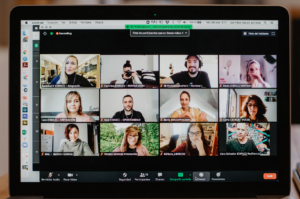by Yasmin Kranewitter
Global virtual teams enable people worldwide to work together seamlessly despite distances. However, virtual teams face new challenges. Learn to give effective feedback in global virtual teams.
One area that can be particularly tricky is giving feedback. 48% of remote workers and 56% of managers rate communication and feedback as top challenges. This was found by a study of the Society for Human Resource Management. Lack of face-to-face interaction, time zones, and cultural differences make timely feedback difficult. However, an efficient feedback culture is essential for building trust, improving performance, and enhancing team cohesion. Virtual teams must develop strategies to overcome challenges and create a supportive feedback culture.
This blog article sums up the main points from a LinkedIn Live talk about how to give feedback in global virtual teams with Lech Guzowski (Culture Facilitator and Founder) and Barbara Covarrubias Venegas (Founder #virtualspacehero).

Lech Guzowski – Workplace Culture Facilitator.
Lech helps CEOs and CHROs create cultures to overachieve business results.
He believes in creating a culture that goes beyond just fitting in, but one that truly stands out. He helps you design your ideal culture and craft initiatives to bring it to life.
As a leadership coach, Lech doesn’t just skim the surface, he dives deep into the complexities of self-awareness to unleash the full potential of individuals.
Connect with Lech on LinkedIn here.
What to Consider When Giving Feedback in Global Virtual Teams?
✅ Make Feedback Intentional
In virtual teams, it is easier for members to avoid giving feedback compared to on-site settings. This makes it all the more important to establish a culture of intentional feedback by setting clear expectations for feedback-giving. Set aside time for feedback during meetings or schedule regular feedback sessions. This ensures that feedback in global virtual teams is given the attention and time it deserves.
✅ Use Digital Tools
Digital tools can be extremely useful for giving feedback in virtual teams. Platforms like Miro, Trello, or Google Workspace provide a quick and easy way to share feedback with team members. They also offer the possibility to store feedback for future reference. Choose the right feedback tool based on your team’s needs to enhance feedback and collaboration.
✅ Be Specific and Act Quickly
Providing specific feedback and doing so in a timely manner are crucial components of effective feedback. When giving feedback, always provide specific examples that illustrate the issue you are addressing. This helps colleagues better understand the situation and enables them to address the issue more effectively. Give feedback promptly to prevent issues from escalating. By providing timely feedback, you can help ensure that team members are able to work on the issue right away, preventing it from becoming a larger problem later on.
✅ Consider Potential Language Barriers
Another factor to keep in mind when providing feedback in global virtual teams is the potential language barrier. Not all team members are native English speakers or feel confident speaking it. This might lead to misunderstandings and misinterpretations, which can hinder the team’s continuous improvement. Therefore, establish a “safe space” for members to ask for clarification and make mistakes without fear. Additionally, clear and concise communication is crucial when providing feedback. Using simple language and avoiding jargon and idioms can help ensure that team members understand each other clearly and can address feedback more effectively.
Be Aware of Cultural Differences
More often than not, in global virtual teams members come from different cultural backgrounds, and feedback styles can vary widely between cultures. For example, in some cultures, direct feedback can be seen as confrontational, while in others, it may be expected. Therefore, it’s crucial to understand the cultural norms of your team members and adjust your feedback accordingly.
Be aware of different cultural communication styles and respect cultural differences. Approach this with respectful curiosity, asking questions about colleagues’ cultural norms regarding feedback-giving. This will help you understand their expectations and adapt your feedback approach accordingly.

Feedback Frameworks for Your Daily Work
To conclude with concrete examples of what effective feedback could look like, we would like to sum up by providing you with two innovative frameworks.
➡️ Firstly, the so-called “4A approach”, also used by Netflix, has gained popularity in recent years. It emphasises Attention, Amplification, Alignment, and Accountability. Attention refers to focusing on the most impactful and relevant aspects of a colleague’s work when giving feedback. Amplification highlights the importance of providing concrete suggestions for improvement, while Alignment ensures that the feedback suggestion is aligned with the team’s larger goals and values. Lastly, Accountability specifies who should be responsible for implementing the suggested changes.
➡️ Another popular feedback approach is the so-called “feedforward approach”. Rather than focusing and commenting on past situations, as is done by “feedback”, feedforward focuses on encouraging improvement in the future. By highlighting what can be improved going forward, feedforward helps to establish a more optimistic and future-oriented feedback culture.

In conclusion…
Virtual teams face unique challenges when it comes to giving feedback due to factors such as distance, cultural differences, and language barriers. However, intentionally making time for feedback, using digital tools, providing specific feedback on time, and being aware of cultural differences can greatly enhance the effectiveness of feedback in virtual teams.
Furthermore, incorporating feedback frameworks such as the 4A approach or the feedforward approach help with providing effective feedback. By considering these issues, virtual teams can overcome the challenges of giving feedback and create a feedback culture that supports team growth and success.




